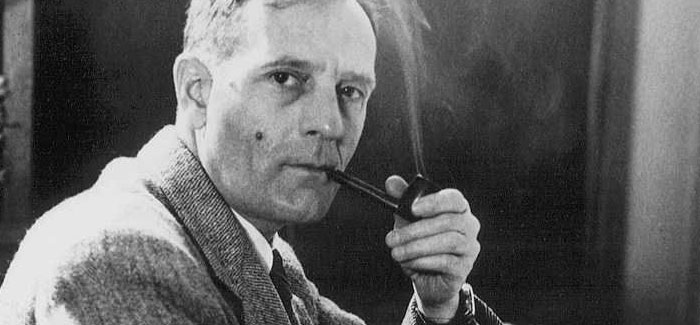
(Courtesy Western Washington University Planetarium)
After more than 20 years in the field, the Hubble Space Telescope’s time dwindles.
In 2009, astronaut John Grunsfeld, SM’84, PhD’88, packed something special for his space shuttle flight to refurbish the Hubble Space Telescope: a 100-year-old basketball used by University athletics star, astronomer, and telescope namesake Edwin Hubble, SB 1910, PhD 1917. While serving as a lighthearted photo op, the souvenir’s journey also linked past and future perspectives of the cosmos.
The telescope, which delivered breathtaking, never-before-seen images of distant space, not to mention data to help explain complex phenomena like dark energy, black holes, and the approximate age of the universe, was named after Hubble to honor his own long-standing influence on the field. After studying science as an undergraduate at the University, where he also had a job as a lab assistant for future Nobel laureate Robert Millikan, Hubble went to Oxford as a Rhodes scholar. There, in accordance with the wishes of his dying father, he explored law, but eventually returned to the University and his original passion.
While still a graduate student working at the University’s Yerkes Observatory, Hubble was offered a staff position at Mount Wilson Observatory near Pasadena by its founder, former University astrophysics professor George Ellery Hale. Hubble deferred in order to serve in World War I (after hurriedly completing his thesis), where he served in France and rose to the rank of major. Upon his return, Hubble began working at Mount Wilson. There, he made the observations that led him to theorize that there are galaxies beyond our own. Hubble also proposed that the universe is ever expanding and devised a system for classifying galaxies that is used to this day.
“Hubble introduced cosmology,” says astronomy and astrophysics professor Don York, PhD’71, who has used data from the telescope to study interstellar matter: gases and dust between the stars. “Before Hubble, there was no universe outside of our own galaxy.” He was the first to propose that “the fuzzy patches in the sky were galaxies,” and he argued that they were expanding. “Once his papers were published, it took a day for the world to change.”
Several University researchers rely on the Hubble for their current work, but obtaining observation time is an arduous process. First, researchers must submit proposals to the Space Telescope Science Institute in Baltimore, where a panel evaluates them. “More than 1,000 proposals are submitted each year, and perhaps 150 to 200 of those get accepted,” says astronomy and astrophysics senior scientist Daniel Welty, SM’79, PhD’85. Once a proposal has been accepted, the next task is to compose a detailed set of instructions specifying how the telescope should locate the targets, the exact instrumental configurations to be used, and how long to observe each target. Then you wait for the data to be obtained.
Welty uses spectra from the telescope to study interstellar matter in two nearby galaxies where heavier elements, which become more abundant as a galaxy ages, are relatively scarce. “They may be similar to very distant galaxies earlier in the evolution of the universe,” he says. These “local” galaxies—only 160,000 to 200,000 light-years away—thus may help scientists understand the much more distant ones that can’t be studied in detail even with Hubble.
Jacob Bean, assistant professor of astronomy and astrophysics, is studying the atmosphere of GJ1214b, a “super-earth”—a planet larger than our own—by observing it as it passes in front of a nearby star every day and a half for about an hour, making the star appear to blink. That hour gives the Hubble its chance. “We’ve got this telescope whizzing around the earth at 17,000 miles an hour, and it just catches it at that right moment in time,” he says. It’s “a truly remarkable dance.”
Thanks to repair missions such as Grunsfeld’s (now associate administrator for NASA’s science mission directorate), the telescope has enjoyed a long life since its launch in 1990. But with the space shuttle program having ended in 2011, the Hubble will be functional only as long as all its parts continue to work. Meanwhile, Hubble’s replacement, the James Webb Space Telescope, is being built and is scheduled to launch in 2018.
“Next time something breaks, that could be the end. That could be tomorrow,” says Bean. Now that there is no longer a space shuttle available to escort the 12-ton-plus telescope back to Earth, there is no way to ensure it will arrive at a predetermined final resting place. “It’s slowly drifting to lower and lower altitudes,” says Bean. “If left alone, it will eventually crash into the earth on its own, and that’s a bad idea because who knows where that will be.” One home that was originally suggested was the Smithsonian. “That would have been great. I think many scientists would have made the pilgrimage to go see it,” laments Bean.
Some astronomers seem a little perplexed by nonscientists’ reactions to the telescope. According to York, people are fascinated because Hubble images offer “so much detail. And the most interesting places in astronomy are just full of stars, full of gas, full of dust, full of explosions and supernovae, most of which is hidden from you from the ground. Most people couldn’t tell you actually what’s in a Hubble image. They just know it’s dramatic. … Why, psychologically, that excites people, I don’t know.”
Bean knows scientists who aren’t themselves immune to the charms of the soon-to-be-defunct telescope. His PhD adviser at the University of Texas, who has worked with the Hubble for most of his career, is one. “He’s made the joke—I don’t know how serious he is—that he wants to take a cruise ship out and watch it being deorbited—you know, watch the meteorites-type streak across the sky of it. So I think there are a large number of people that probably have a very strong sentimental attachment to the telescope.”
